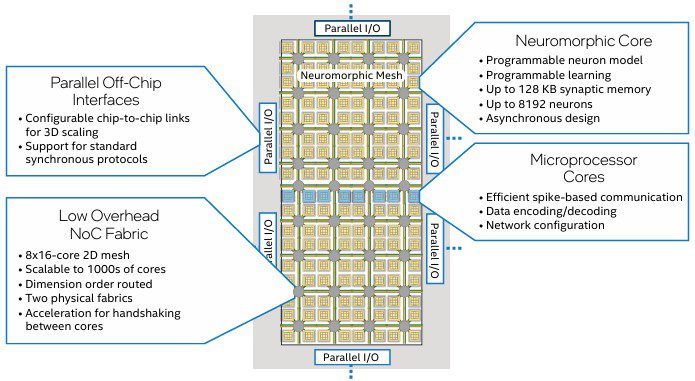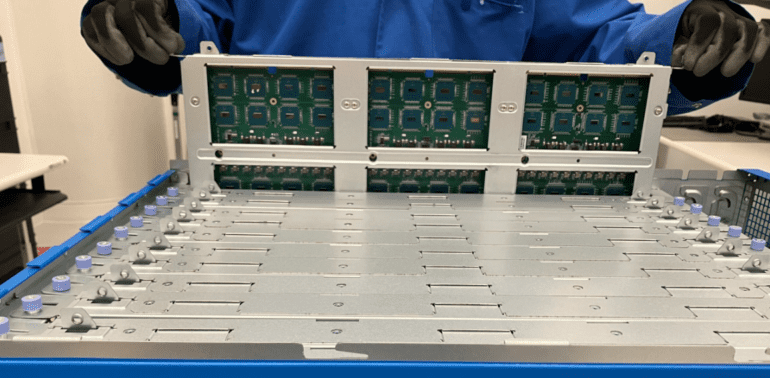- Sandia National Laboratories unveils Hala Point, integrating 1,152 Loihi 2 neuromorphic processors.
- Loihi 2 chips leverage Intel 4 process, offering enhanced efficiency with 1 million neurons and 123 million synapses.
- Hala Point processes 380 trillion synaptic operations and 240 trillion neuron operations per second.
- The supercomputer achieves 20 petaops of computational throughput at a power efficiency of 15 teraops per watt.
- Future scaling could match the human brain’s computational capacity but at significantly higher power consumption and space requirements.
Main AI News:
In the realm of data centers, few devices boast the cutting-edge Intel 4 process—a refinement of the 7-nanometer extreme ultraviolet immersion lithography. However, among these select few is Intel’s Loihi 2 neuromorphic processor. Sandia National Laboratories, in a groundbreaking move, is unleashing a supercomputer housing 1,152 of these processors, intricately interconnected to forge what Intel heralds as the most extensive neuromorphic system ever assembled.
As Nvidia’s premier “Blackwell” GPU accelerators breach the 1,200-watt mark in peak configurations, demanding liquid cooling, and with other accelerators poised to follow suit, it’s prudent to pause and contemplate the potential of a reasonably scaled neuromorphic system. Such systems not only mimic the behavior of neurons found in biological brains but also consume orders of magnitude less power than traditional XPUs ubiquitous in data centers.
The landscape of next-generation computing architectures captivates our attention here at The Next Platform. We vigilantly monitor advancements in dataflow engines, neuromorphic processors, and quantum computers, anticipating the moment when these technologies mature sufficiently to tackle real-world workloads at scale. Our gaze is fixed on IBM’s TrueNorth initiative, BrainChip’s Akida neuromorphic processor, Knowm’s memristor-based storage, and Intel’s Loihi 1 and Loihi 2 chip families.

Source: The Next Platform
At the core of Sandia’s latest innovation, the Hala Point system, lies the Loihi 2 neuromorphic processor. This system undergoes rigorous testing to assess its applicability across various artificial intelligence workloads, offering a comparative analysis against AI methodologies reliant on CPUs, GPUs, and other computational engines. Sandia’s inclination toward exploring new architectures aligns seamlessly with the mission of national high-performance computing (HPC) labs worldwide.
Intel’s maiden Loihi neuromorphic chip debuted in September 2017 under the auspices of Intel Labs, the chipmaker’s research arm. This chip found its way into the Pohoiki Beach system, featuring 64 Loihi 1 processors interlinked, before emerging in July 2019. Intel touted the Loihi 1’s spiking neural network architecture, akin to the neural pathways in the human brain, equating it to roughly 130,000 neurons and 128 million synapses. Subsequently, Intel upscaled to the Pohoiki Springs system, comprising over 800 Loihi chips, boasting over 100 million neurons for AI models—a mere fraction of the human brain’s 100 billion neurons.
While Pohoiki Beach and Pohoiki Springs were accessible to hundreds of AI researchers through Intel Labs, they have yet to be commercialized. Similarly, the Hala Point system, based on the second-generation Loihi 2 neuromorphic processor, remains outside the commercial realm. Nonetheless, it finds purpose at Sandia, where the Whetstone tool facilitates the conversion of various convolutional neural networks to spiking neural networks, suitable for Loihi-based machines.
By transitioning to the Intel 4 process, the Loihi 2 chip achieves roughly half the size of its predecessor while accommodating the same number of neuron cores—now augmented to 1 million—and nearly identical synaptic capacity at 123 million.
The proliferation of embedded processor cores on the Loihi device, now doubled to six from three on the Loihi 1, enables enhanced data encoding and decoding capabilities for spiking neural network software.
Enter Hala Point—a marvel comprising 1,152 Loihi 2 chips. This ensemble at Sandia boasts 140,544 neuron cores and 2,304 host X86 cores, yielding a cumulative neuron count of 1.15 billion, akin to the cognitive capacity of an owl’s brain. Hala Point hosts a staggering 138.2 billion synapses, housed within a dozen cards across server nodes, each card accommodating six Loihi 2 compute complexes housing eight chips apiece. This consolidation results in 576 Loihi 2 chips within a 6U rack-mounted enclosure, consuming a modest 2,600 watts and fitting neatly within 12U of a standard 42U rack.
Hala Point’s computational prowess is equally remarkable, boasting the capability to process 380 trillion synaptic operations per second, 240 trillion neuron operations per second, and an aggregate memory bandwidth of 16 PB per second. Leveraging sparse deep neural networks at 8-bit data resolution, this 12U colossus achieves the equivalent of 20 petaops of computational throughput, boasting a power efficiency of 15 teraops per watt.
But why stop there? A mere 174 of these 6U enclosures, representing an 87X increase in computing power over Hala Point, would rival the neuronal count of the human brain.
Intriguingly, while the human brain operates on a mere 20 watts of power, 174 enclosures of this caliber would consume 226.2 kilowatts—exceeding the brain’s energy consumption by a factor of 11,310. Occupying 25 racks of space, totaling 1.55 million cubic inches, this hypothetical Loihi 2 cluster falls short of the human brain’s space efficiency by a factor of 128,900.
Moreover, contemplating the trajectory of Moore’s Law, a doubling of chip density every two years could, theoretically, close the gap in space efficiency within 34 years and in energy efficiency within 27 years. The advent of 3D stacking, a viable prospect for Loihi chips, could expedite this convergence and yield a more pragmatic computational paradigm.
Yet, an intriguing question persists: What if we could simulate a human brain with 1 trillion or even 10 trillion neurons, eclipsing the cognitive capacity of the human brain? Would such a simulated entity exhibit heightened intelligence?
In the wake of our current existential challenges, one thing remains certain: Humanity’s insatiable quest for knowledge will drive us to explore these questions. Remarkably, the pursuit of simulating cognitive capacities appears more financially feasible than ever—an endeavor far less daunting than harnessing the computational might of countless GPUs.
Conclusion:
The introduction of the Hala Point supercomputer marks a significant advancement in neuromorphic computing, showcasing the potential for efficient, brain-inspired processing at scale. While promising in terms of computational capabilities, the market implications suggest a need for continued innovation in power efficiency and spatial optimization to realize the full potential of neuromorphic computing in commercial applications.

